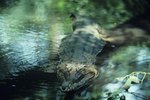
Looking as though they are wearing a helmet, chinstrap penguins (Pygoscelis antarcticus) derive their names from the thin bands of feathers that circle the bottom of their faces. Chinstrap penguins are among the few animals that can survive the incredibly harsh climate of the Antarctic, and do so in part because of their physical adaptations. Their heavily-insulated, torpedo-shaped bodies help them avoid the cold and travel through the water and over the ice.
Size and Shape
Chinstrap penguins are medium-sized penguins that stand about 2 feet high. Their weight fluctuates throughout the year, coinciding with the ebb and flow of food. At their heaviest, adults weigh up to about 12 pounds. Their torpedo-like body shape reduces water resistance and allows chinstrap penguins to cut through the water quickly; this helps them swim fast enough to capture prey and evade predators. Additionally, like many other penguins species, their body shape allows chinstrap penguins to move about on land by lying on their bellies and pushing themselves across the snow and ice with their feet and flippers.
Counter Shaded Color Scheme
Chinstrap penguins have jet-black dorsal surfaces that contrast starkly with their white ventral surfaces. Scientists term animals with such two-toned color patterns as "counter-shaded." This color scheme protects the penguins from predators from multiple directions -- dark dorsal colors are camouflaged against the dark surface of the water when viewed from above, while white ventral surfaces camouflage with the sky when viewed from below.
Easy Identification
You can easily identify chinstrap penguins by noting the white face and namesake black line under the beaks. Juveniles have spots around the face until their first molt, which occurs at just over one year of age. Male and female chinstrap penguins have similar colors and patterns, making it nearly impossible to distinguish the genders visually.
Wings, Beaks and Feet
The wings of penguins have evolved to help them swim rather than fly. Chinstrap penguins feed primarily on krill, so their flippers must be strong enough to propel them through the water at great speed in order to capture enough of the tiny crustaceans. Black beaks blend in with the black and white markings on their faces. The webbing between the toes of their pink-tinted feet greatly improves their swimming ability. These birds are designed for all aspects of their environment.
Icy Insulation
Chinstrap penguins are covered in short, dense feathers that shield them from icy air. Additionally, the feathers form a waterproof barrier, which keeps the penguin’s body dry when they enter the water. Underneath the feathers and skin, penguins have a thick layer of blubber that further insulates them from the cold -- the blubber layer also serves as a storage site for excess calories.
References
Photo Credits
-
Jupiterimages/Photos.com/Getty Images




